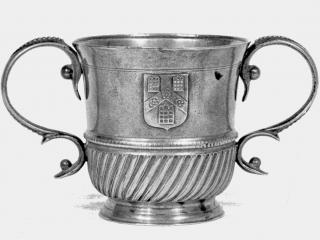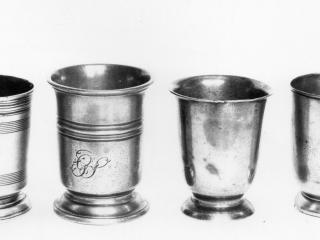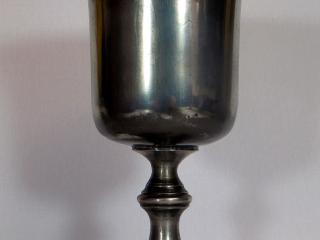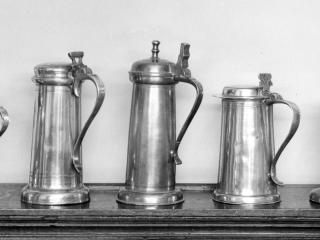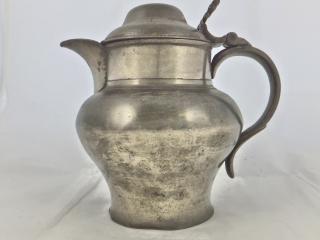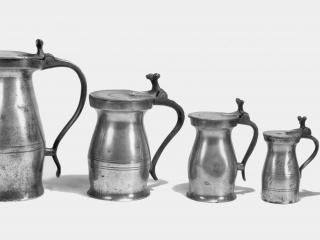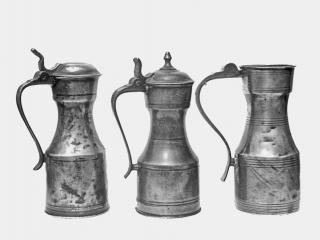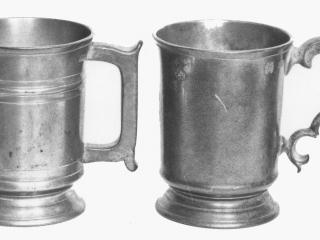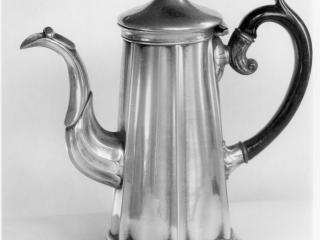Pewter for drinking
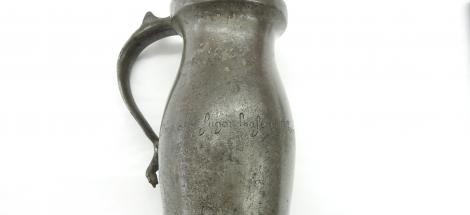
The categories outlined below are those used by the Pewter Society database.
Cups and beakers
Two-handled Cups
Two-handled cups are found in several sizes. In Britain there are a few large two-handled bowls known as “Loving Cups”. Some of these may have been “Wassail” cups; that is, passed from hand to hand on convivial occasions, but it is more likely that they were gifts upon betrothal or marriage. Loving cups of this style appear about 1650 and go out of fashion around 1730. Later in the eighteenth century smaller cups appear. Some may have been used as chalices in Britain , but most were for ordinary domestic use. Two-handled cups from the mid-eighteenth century onwards are found in a number of styles.
Drinking Cups
Small single-handled cups were used everywhere. From the seventeenth century come small concave-sided cups used in Britain and Holland, but most examples date from the eighteenth century and have straight, slightly tapering or rounded sides.Some rather exalted names are given to these cups including “possett” and “caudle”, but in reality they were probably used for drinking almost any liquid. A lot of examples date from the nineteenth century.
Beakers
The term “beaker” is used to describe drinking cups with straight bodies and without handles. Beakers were used in the Middle Ages but few have survived. In the seventeenth century we find a small group of cast decorated beakers found in Britain dating from around 1610. Later in the seventeenth century similar tall beakers were popular in Britain, many decorated with wrigglework.
The tall beaker went out of fashion in Great Britain around 1720, but continued to be made in the United States and Scandinavia into the nineteenth century.
In the eighteenth century beakers were made in several styles. In Britain shorter examples were popular, first appearing about 1720. Beakers are found with plain, decorated and reeded bodies. Most British beakers are half pints . Some smaller size beakers with Scottish marks may have originally fitted into the top of tappit hens.
Goblets
Goblets are defined here as cups similar to beakers, but with curved sides and a small stem or foot. Examples with decorated sides were popular in France and Switzerland around 1750. British goblets however are usually plain and are predominantly nineteenth century.
Wine Cups
Wine cups were used from an early period for drinking wine or “strong” ale. They resemble chalices and are often mistaken for them.
The main differences are that wine cups tend to be shorter and usually have simple, plain stems without knops. They graced the tables of many homes from the seventeenth century onwards, until they went out of fashion around 1730. Examples from Britain and northern Europe predominate.
Flagons and jugs
A flagon is normally any large lidded vessel with a handle from which drink is served .In the 14th century the main design known in pewter is octagonal , this then evolved to a round bellied or pear shaped flagon a few examples are in church treasuries. From 1603 after James 1st stated that all churches must have a vessel to dispense the wine , a standard flagon appeared which had a bullet base tapered sides domed top and knop ,known as James 1st type this evolved to a Charles 1st style with a bun shaped top to a beefeater flagon with a lid that looks like a beefeaters (yeoman warders) hat. All of the last 3 are from the 17th century . Flat lidded flagons were the next to appear at the beginning of the 18th century and by the middle of the century spire flagons appeared . Regional variations in York produced a domed flagon looking like an elongated tankard and the acorn type .
Bulbous pewter jugs with double-C handles were illustrated in the catalogues of Farrow and Jackson of London in 1898, Brown and Englefield of London in 1903 and Gaskell and Chambers of Birmingham in 1921 and Englefields (London) Ltd after the second World War (Englefield 1997 p74). Most surviving jugs are therefore probably late C19 or early C20, and there is no evidence to support the much earlier date attributed by some authors. Whilst these jugs have often been called ale, cider or wine jugs, Farrow and Jackson, Brown and Englefield and Englefields, all called them ‘water jugs’. Gaskell and Chambers just called them ‘jugs’.The high-bellied body shape of the jugs is fairly common but thumbpiece design varied: Gaskell and Chambers using a spray but Farrow and Jackson used an open chairback. They were made in sizes ranging from ½ pint to gallon.
Measures
Measures as the names implies are a range of vessels produced to the standard of the time to dispense liquid , grain , medicines and even shellfish .The basic shape did not change from c1500 to the end of the 18th century and are normally dated by the style of handle and thumbpiece . The hammerhead thumbpiece was being used on baluster measures as early as C15, but the majority of surviving examples are from the second half of C17 or the very beginning of C18.There are more fake than genuine hammerheads. The so-called double volute thumbpiece appeared on English baluster measures in the 1720s or 30s and continued until the introduction of the Imperial Standard in the 1820s. Bud balusters were made from the last quarter of C17 through to the first quarter of C19. From 1836 when the new imperial standard was introduced a bellied shape appeared which then was produced into the 20th Century , measures from this time are normally verified by a stamp.
Tappit hens are a uniquely-Scottish form of measure. They were made in Edinburgh and Glasgow from late C17 to the end of C19,though many reproductions were also made in C20. Glasgow tappit hens have taller thumbpieces, often with 3 bars at the top. They tend to have 5-part hinges whereas Edinburgh examples usually have 3-part. The underside of the top of the handle is usually straighter in Glasgow made items, which also have a foot rim that projects down and out. Those with a knopped lid are called ‘crested’. Prior to the introduction of Imperial Standard in 1826 most were made to the old ‘Scots pint’ capacity standard, which was roughly 3 Imperial pints,though Edinburgh used Old English Wine Standard from ca.1800 to 1826. The chopin and mutchkin were half and a quarter of a Scots pint respectively.
Mugs
A mug is a lidless drinking vessel with a handle, there are various regional styles but all are made in 3 or 4 graduated sizes ,half pint ,pint and quart being standard. The pre imperial types in old english ale or wine standard but there are local standard variations as in the Winchester standard ,Henry VII standard and the 15 oz pint.
The first “pots” that we know of appear in English taverns around 1650; the early examples are tall with heavy banding, but in about 1690 — 1700 mugs with plain bodies appeared.
Eighteenth century tavern mugs are uncommon. The tall early form gave way to squat tankards, usually with a ball terminal to their strap handles. Examples before about 1750 tend to differ from maker to maker. About the middle of the eighteenth century, mugs with a “tulip” shape or with “U” shaped body were introduced.
The nineteenth century saw the rise of a popular shape variously known as the “pear”, “belly” or “bulbous” form. More mugs of this type were made than of any other form and they continued to be popular up to the beginning of this century. The smallest capacity made prior to 1850 was the half gill and most common are the quart, pint, half pint and gill, although gallons and half gallons are known. The smaller fractions only appear after 1850. Many local or regional varieties of mug were made in the nineteenth century and there is a range of tavern mugs made to the Scottish Standard that was only used north of the border.
Glass-bottomed mugs began to appear in the 1790’s, some with clear bases, others with coloured glass, and they continued to be used throughout the nineteenth century.At some point in the mid-nineteenth century makers developed a range of mugs with thickened lips or rims. These were made with brass, pewter or copper lips or rims, the thickening presumably intended to strengthen them for the heavy wear they received. These rims are found on both straight-sided and “belly” forms.These were probably used in the sale of shellfish or grain.
Many tavern mugs have an inscription on their sides or under their bases showing the “pub” where they were used. Quarts are slightly more common in Britain than pints and the larger and smaller sizes are all less frequently found.
Until the 1840’s two forms of handles predominated; the plain strap and the “broken” handle . A range of new mugs with rectangular or oval handles and with different body forms were gradually introduced into English pubs and many of these forms were still popular in 1900.Up to 1826 mugs were mostly made to the ale standard but, particularly in the eighteenth century, rarer examples conformed to the wine standard.The majority of mugs found today will be from the 19th century , the lidded tankard declined as the mug increased
Tankards
A tankard is a lidded drinking vessel. Unlidded drinking vessels with a handle are called ‘mugs’. Although it seems strange now to drink out of a lidded vessel this was the norm until the second half of the 18th century. Perhaps this was because ceilings were not plastered underneath, so without a lid you stood the risk of having dirt, straw and spiders dropping into your ale.
The earliest surviving pewter tankards date from the mid 17th century. They are straight-sided and have a lid that is raised with a flat top. These have become known to collectors as ‘flat lid tankards’, an unfortunate term because the lid as a whole is not flat. The thumbpiece on which the user presses to raise the lid is often of a very attractive design. The flange of the lid overhangs the body and may have decorative projections (‘denticulations’) on the front.
Around 1700 the dome lid started to appear. With these, the flat area of the lid is replaced with a second dome (which is why they are sometimes called ‘double dome lids’). A little later tulip-shaped bodies appeared, though straight-sided bodies continued as well. The production of tankards diminished towards the end of the 18th century as unlidded drinking vessels became more popular, but they enjoyed a revival in the 19th century when they were once more produced for trophies.
Many flat lid tankards are decorated with wrigglework, though beware – some wrigglework was added in the 20th century. Other styles of tankard are normally plain save for inscriptions and the like.
Tea and coffee pots
Tea appeared in Great Britain in the reign of Charles the second, due to the cost at the time it was mainly drunk by the wealthy from china or silver pots. By the 1750s it was britains most popular drink and tea now was more affordable . Early teapots made of pewter made an appearence at that time and were bullet shaped , with the invention of brittania metal the cost became cheaper and a large amount of different styles appeared, the majority of them being made in Sheffield and Birmingham . They were made in 8 different sizes ranging from one cup to 8.
The first coffee house was opened up in Oxford in 1650 and by the end of the century over 3000 coffee houses were open. Coffee pots were produced basically on the same time line as tea pots but their use declined after the invention of the coffee perculator at the end of the 19th Century.
